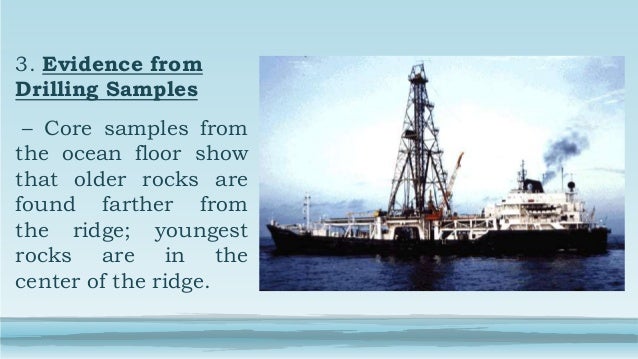Seafloor spreading occurs along mid ocean ridges large mountain ranges rising from the ocean floor.
Seafloor spreading evidence examples and explanations.
First proposed in the early 1960s by the american geologist harry h.
For example 400 million year old magnetite in europe pointed to a different north magnetic pole than the same aged magnetite in north america.
Several types of evidence supported hess s theory of sea floor spreading.
Hess its major tenets gave great support to the theory of continental drift continental drift geological theory that the relative positions of the continents on the earth s surface have.
This evidence led scientists to look again at wegener s hypothesis of continental drift.
The mid atlantic ridge for instance separates the north american plate from the eurasian plate and the south american plate from the african plate the east pacific rise is a mid ocean ridge that runs through the eastern pacific ocean and separates the pacific plate from the north american.
As the seafloor spreading axis moves along the margin thermal uplift produces a ridge.
This evidence was from the investigations of the molten material seafloor drilling radiometric age dating and fossil ages and the magnetic stripes.
The rate at which new oceanic lithosphere is added to each tectonic plate on either side of a mid ocean ridge is the spreading half rate and is equal to half of the spreading rate.
Seafloor spreading theory of lithospheric evolution that holds that the ocean floors are spreading outward from vast underwater ridges.
Around 250 million years ago the north poles were also different for the two continents the scientists looked again at the three possible explanations.
Evidence of sea floor spreading harry hess s hypothesis about seafloor spreading had collected several pieces of evidence to support the theory.
A veritable legion of evidence supports the seafloor spreading hypothesis.
A profound consequence of seafloor spreading is that new crust was and still is being continually created along the oceanic ridges.
Eruptions of molten material magnetic stripes in the rock of the ocean floor and the ages of the rocks themselves.
Spreading rates determine if the ridge is fast intermediate or slow.
Molten rock erupts onto the seafloor there then cools and rifts away from the ridge on either side in a process known as seafloor spreading.
Spreading rate is the rate at which an ocean basin widens due to seafloor spreading.
Evidence for sea floor spreading.

